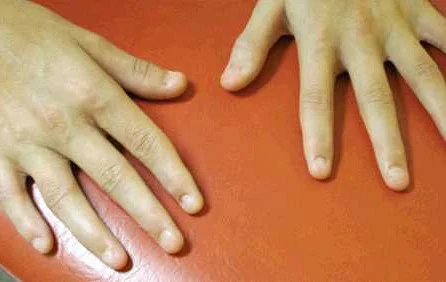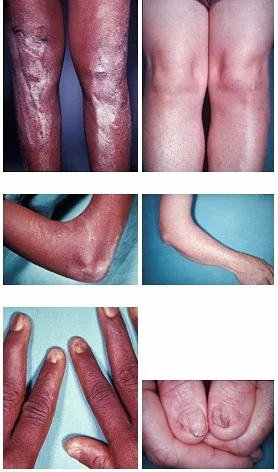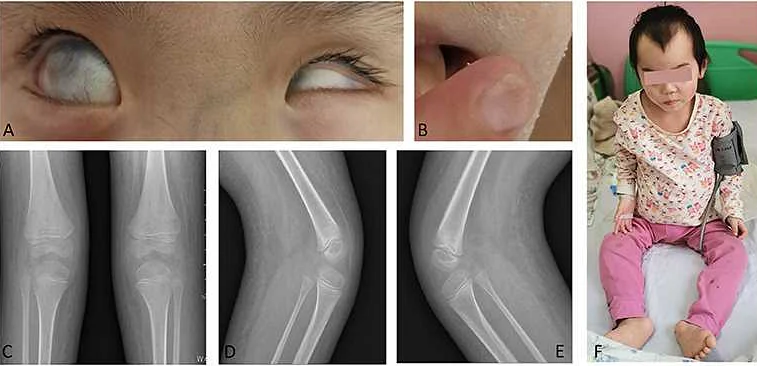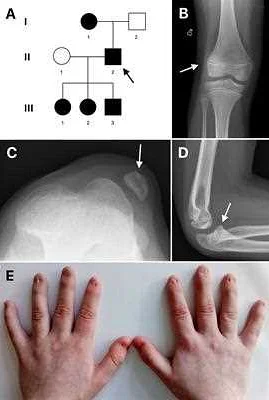Nail-patella syndrome
Содержимое
Nail-patella syndrome is a rare genetic disorder that affects the development of nails, kneecaps, elbows, and kidneys. This article provides an overview of the causes, symptoms, and treatment options for nail-patella syndrome.
Nail-Patella Syndrome, also known as hereditary onycho-osteodysplasia, is a rare genetic disorder that affects the development of nails, bones, and kidneys. It is characterized by abnormalities in the shape and size of the fingernails and toenails, as well as skeletal and renal anomalies.
The main symptoms of Nail-Patella Syndrome include small, underdeveloped, or absent nails, especially the thumbnails and kneecaps. In addition, individuals with this condition may experience skeletal malformations such as elbow and knee abnormalities, scoliosis, and hip dysplasia. Kidney problems, including proteinuria and nephrotic syndrome, are also commonly associated with this syndrome.
The exact cause of Nail-Patella Syndrome is a mutation in the LMX1B gene, which is responsible for the development of limbs, kidneys, and eyes. This mutation can be inherited in an autosomal dominant pattern, meaning that an affected person has a 50% chance of passing the condition on to their children.
Although there is no cure for Nail-Patella Syndrome, treatment is focused on managing the symptoms and complications associated with the condition. This may include physical therapy to improve mobility and prevent joint deformities, medications to manage pain and kidney problems, and surgery to correct skeletal abnormalities or relieve pressure on the nerves. Regular screenings and follow-up care are essential to monitor kidney function and address any potential complications.
Overview of Nail-Patella Syndrome

Nail-Patella Syndrome, also known as Turner-Kiser Syndrome, is a rare genetic disorder that affects the development of nails, bones, kidneys, and other parts of the body. It is an autosomal dominant condition, which means that a person only needs to inherit the gene mutation from one parent in order to develop the syndrome.
People with Nail-Patella Syndrome often have abnormalities in their nails, such as underdeveloped or absent nails. They may also have skeletal abnormalities, including poorly developed or missing kneecaps, and a range of other bone and joint issues. In addition, individuals with this syndrome may experience kidney problems, such as abnormal filtering or excessive protein in the urine.
The signs and symptoms of Nail-Patella Syndrome can vary greatly from person to person. Some individuals may have mild symptoms, while others may experience more severe complications. It is important for individuals with Nail-Patella Syndrome to receive regular medical care and monitoring to manage and treat any potential complications.
There is currently no cure for Nail-Patella Syndrome, so treatment focuses on managing symptoms and preventing complications. This may include physical therapy to improve mobility and strengthen muscles, medications to manage pain and inflammation, and surgical interventions to correct skeletal abnormalities or kidney issues.
It is important for individuals with Nail-Patella Syndrome to work closely with a team of healthcare professionals, including geneticists, orthopedic surgeons, and nephrologists, to develop a comprehensive treatment plan that addresses their unique needs and symptoms.
While living with Nail-Patella Syndrome may present challenges, many individuals are able to lead fulfilling lives with appropriate management and support from healthcare providers and their loved ones.
Key Points:
- Nail-Patella Syndrome is a rare genetic disorder that affects the development of nails, bones, kidneys, and other parts of the body.
- People with Nail-Patella Syndrome may have underdeveloped or absent nails, skeletal abnormalities, and kidney problems.
- Treatment focuses on managing symptoms and preventing complications through physical therapy, medication, and surgical interventions.
- Collaboration with a healthcare team is crucial to developing an individualized treatment plan.
Common Signs and Symptoms of Nail-Patella Syndrome

Nail-Patella Syndrome is a rare genetic disorder that affects multiple parts of the body, particularly the nails, elbows, knees, and kidneys. It is important to recognize the common signs and symptoms of this syndrome in order to seek appropriate medical care and management.
- Abnormal or absent fingernails and toenails: Individuals with Nail-Patella Syndrome often have abnormal nail growth or may completely lack nails. The nails may be small, pitted, discolored, or misshapen.
- Elbow deformities: Some individuals with Nail-Patella Syndrome may have abnormalities in the shape and structure of their elbows. These can include underdeveloped or absent elbow joints, limited range of motion, and difficulty in fully straightening or bending the arms.
- Knee abnormalities: Knee abnormalities are common in Nail-Patella Syndrome and can range from mild to severe. The kneecaps may be small, irregularly shaped, or dislocated. Some individuals may experience pain or difficulty with walking and running due to these knee abnormalities.
- Kidney problems: Nail-Patella Syndrome can also affect the kidneys. Individuals may develop kidney abnormalities such as proteinuria (presence of excess protein in the urine), hematuria (blood in the urine), or even kidney failure in severe cases. Regular monitoring of kidney function is important in individuals with Nail-Patella Syndrome.
- Skeletal abnormalities: In addition to the nails, elbows, knees, and kidneys, Nail-Patella Syndrome can also cause skeletal abnormalities in other parts of the body. These can include hip dysplasia, scoliosis (curvature of the spine), and abnormal bone growth.
- Eye problems: Some individuals with Nail-Patella Syndrome may also experience eye problems such as glaucoma or cataracts. Regular eye examinations are important to detect and manage these issues.
If you or your child exhibit any of these signs and symptoms, it is important to consult with a healthcare professional who can provide a proper diagnosis and develop a personalized treatment plan. Early detection and intervention are key in managing the symptoms and complications associated with Nail-Patella Syndrome.
Understanding the Causes of Nail-Patella Syndrome

Nail-Patella Syndrome, also known as NPS or hereditary onycho-osteodysplasia, is a rare genetic disorder that affects the development of nails, bones, and other parts of the body. It is caused by mutations in the LMX1B gene, which is responsible for the production of a protein that plays a crucial role in the formation of limbs, kidneys, and eyes.
LMX1B gene mutations can be inherited from one or both parents, or they can occur spontaneously during the early stages of fetal development. The exact mechanisms that lead to these mutations are not fully understood, but it is believed that they disrupt the normal function of the LMX1B protein, leading to the characteristic symptoms of Nail-Patella Syndrome.
Individuals with Nail-Patella Syndrome typically have abnormalities in their nails, including small, underdeveloped, or missing nails. They may also exhibit skeletal abnormalities such as poorly formed or absent kneecaps, elbow deformities, and hip dysplasia. Additionally, some affected individuals may have kidney problems, including abnormalities in the structure or function of the kidneys.
In some cases, Nail-Patella Syndrome can be diagnosed prenatally through genetic testing. However, the diagnosis is typically made based on the individual’s physical characteristics and a family history of the condition. Genetic testing can confirm the presence of LMX1B gene mutations, but it is not always necessary for diagnosis.
While there is currently no cure for Nail-Patella Syndrome, treatment is focused on managing the symptoms and complications associated with the condition. This may include physical therapy to improve mobility and strengthen muscles, medication to manage pain and other symptoms, and surgery to address skeletal abnormalities or kidney problems.
| Abnormal nails | Autosomal dominant |
| Skeletal abnormalities | Autosomal recessive |
| Kidney problems | Spontaneous mutations |
In conclusion, Nail-Patella Syndrome is a rare genetic disorder caused by mutations in the LMX1B gene. These mutations disrupt the normal development of nails, bones, and kidneys, leading to characteristic symptoms and complications. While there is no cure, treatment can help manage the symptoms and improve the quality of life for affected individuals.
Diagnosing Nail-Patella Syndrome

Diagnosing Nail-Patella Syndrome can be challenging due to its varied symptoms and genetic nature. A thorough medical history review, physical examination, and specialized tests are essential for an accurate diagnosis.
During a medical history review, the doctor will ask questions about the patient’s symptoms, such as any abnormalities in the nails, knees, or elbows. They will also inquire about any family history of Nail-Patella Syndrome or related conditions, as this condition can be inherited.
During a physical examination, the doctor will carefully assess the patient’s nails, knees, and elbows for signs of Nail-Patella Syndrome. They will look for abnormalities in the shape, size, or texture of the nails, as well as any dislocations or limited range of motion in the knees and elbows. Additionally, they may check for other associated features, such as kidney problems or eye abnormalities.
Specialized tests may be ordered to confirm the diagnosis of Nail-Patella Syndrome. These tests may include genetic testing to identify mutations in the LMX1B gene, which is responsible for the development of nails, knees, and elbows. A blood or saliva sample is typically collected for analysis.
In some cases, imaging studies such as X-rays or magnetic resonance imaging (MRI) may be performed to assess the severity of bone abnormalities in the knees or elbows.
It is important to note that diagnosing Nail-Patella Syndrome may require input from multiple specialists, such as geneticists, orthopedic surgeons, and nephrologists, depending on the specific symptoms present.
| Medical history review | A comprehensive review of the patient’s medical history and symptoms, as well as any family history of Nail-Patella Syndrome or related conditions. |
| Physical examination | A thorough assessment of the patient’s nails, knees, and elbows for signs of Nail-Patella Syndrome, including abnormalities in shape, size, texture, and limited range of motion. |
| Genetic testing | An analysis of the patient’s DNA to identify mutations in the LMX1B gene, which is associated with Nail-Patella Syndrome. |
| Imaging studies | X-rays or MRI scans may be performed to evaluate the severity of bone abnormalities in the knees or elbows. |
Once a diagnosis of Nail-Patella Syndrome is confirmed, the healthcare team can develop an appropriate treatment plan to manage the symptoms and provide support for the patient.